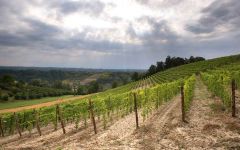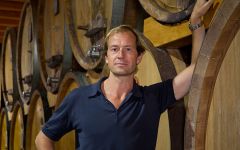Luigi Einaudi Barolo Cannubi 2013
-
James
Suckling -
Wine
Spectator -
Wine
Enthusiast - Decanter



Product Details
Your Rating
Somm Note
Winemaker Notes
Professional Ratings
-
James Suckling
Aromas of cream, light toffee, mushrooms and plums follow through to a full body, silky tannins and a fresh and clean finish. Very tannic yet the tannins are ripe and polished.
-
Wine Spectator
Aromatic, displaying rose, strawberry, cherry and currant flavors, accented by leather, tobacco, iron and tea notes. Firm tannins lay a base of support as this plays out on the finish. All the components are there, but this needs time.
-
Wine Enthusiast
Toast, moist underbrush, grilled herb and balsamic aromas lead the nose. On the full-bodied austere palate, fine-grained tannins support tart cherry, cranberry, vanilla and star anise. Give this several more years to unwind and develop.
-
Decanter
Super-ripe cherry and raspberry nose, with a hint of tar. Very ripe and suave, the palate is packed with fruit but has structure and vigour. Stylish, spicy, and very long. Drinking Window 2020 - 2038
Other Vintages
2019-
Robert
Parker -
James
Suckling -
Wine
Spectator
-
Wine &
Spirits -
James
Suckling -
Wine
Spectator
-
Wine
Enthusiast -
James
Suckling - Vinous
-
Robert
Parker -
Wine &
Spirits -
Jeb
Dunnuck -
Wine
Spectator
-
James
Suckling -
Wine
Enthusiast -
Wine
Spectator
-
Wine
Enthusiast - Decanter
-
Wine
Spectator -
Robert
Parker -
James
Suckling
- Decanter
-
Robert
Parker -
Wine
Spectator -
Wine
Enthusiast -
James
Suckling
-
James
Suckling -
Wine
Enthusiast -
Wine &
Spirits -
Robert
Parker -
Wine
Spectator
-
James
Suckling -
Wine
Spectator -
Wine &
Spirits -
Robert
Parker -
Wine
Enthusiast
-
Wine
Enthusiast -
Robert
Parker -
Wine
Spectator -
James
Suckling
-
Robert
Parker
-
Robert
Parker -
Wine
Enthusiast -
Wine
Spectator
-
Robert
Parker -
Wine
Spectator
-
Wine
Spectator
-
Wine
Spectator
-
Wine
Spectator







It all began in 1897, when 23-year-old Luigi Einaudi (Italy’s first President) purchased the first of the Einaudi estates at San Giacomo. Today, the President’s descendants have chosen to maintain continuity with their extraordinary heritage while looking to the future, turning the oldest wine property in the Dogliani area into a cutting-edge classic. Granddaughter Paola Einaudi, her son Matteo Sardagna, and Giorgio Ruffo – together with technical director Lorenzo Raimondi and winemaker Beppe Caviola – have proven a winning team. Today, the total surface of the property (10 farmsteads) is 358 acres, 111 of which are under vine. The vineyards, in turn, are subdivided into seven terroirs. Four of these are in Dogliani (four hills, one of which is the Vigna Tecc cru, another the premier area of San Luigi), while Barolo comprises two crus (Terlo and Cannubi). Terlo is part of the estate’s original nucleus (marly-calcareous soil at 984 feet above Cannubi hill, at an altitude of 722 feet above sea level), provide a Barolo of superb breed and longevity. The underground winery, located at Tecc and completed in 1993, was gradually doubled in size and provided with state-of-the-art barrel cellars, sophisticated humidity and temperature control systems, and a new-generation bottle cellar stocking over 240,000 bottles.

Responsible for some of the most elegant and age-worthy wines in the world, Nebbiolo, named for the ubiquitous autumnal fog (called nebbia in Italian), is the star variety of northern Italy’s Piedmont region. Grown throughout the area, as well as in the neighboring Valle d’Aosta and Valtellina, it reaches its highest potential in the Piedmontese villages of Barolo, Barbaresco and Roero. Outside of Italy, growers are still very much in the experimentation stage but some success has been achieved in parts of California. Somm Secret—If you’re new to Nebbiolo, start with a charming, wallet-friendly, early-drinking Langhe Nebbiolo or Nebbiolo d'Alba.

The center of the production of the world’s most exclusive and age-worthy red wines made from Nebbiolo, the Barolo wine region includes five core townships: La Morra, Monforte d’Alba, Serralunga d’Alba, Castiglione Falletto and the Barolo village itself, as well as a few outlying villages. The landscape of Barolo, characterized by prominent and castle-topped hills, is full of history and romance centered on the Nebbiolo grape. Its wines, with the signature “tar and roses” aromas, have a deceptively light garnet color but full presence on the palate and plenty of tannins and acidity. In a well-made Barolo wine, one can expect to find complexity and good evolution with notes of, for example, strawberry, cherry, plum, leather, truffle, anise, fresh and dried herbs, tobacco and violets.
There are two predominant soil types here, which distinguish Barolo from the lesser surrounding areas. Compact and fertile Tortonian sandy marls define the vineyards farthest west and at higher elevations. Typically the Barolo wines coming from this side, from La Morra and Barolo, can be approachable relatively early on in their evolution and represent the “feminine” side of Barolo, often closer in style to Barbaresco with elegant perfume and fresh fruit.
On the eastern side of the Barolo wine region, Helvetian soils of compressed sandstone and chalks are less fertile, producing wines with intense body, power and structured tannins. This more “masculine” style comes from Monforte d’Alba and Serralunga d’Alba. The township of Castiglione Falletto covers a spine with both soil types.
The best Barolo wines need 10-15 years before they are ready to drink, and can further age for several decades.
